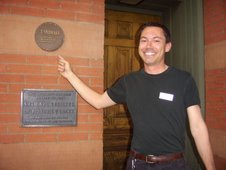Hello History and Baseball fans. Requests have come in asking for insight into what buildings used to be where Coors Field now stands. With the Rockies being in the World Series, what could be a more fitting blog?? My area of discussion usually coincides with the boundaries for downtown listed at DenverInfill.com. Coors Field technically sits just across the street from those boundaries in the Ballpark neighborhood, but this seems like a very fitting occasion!
Answers to these questions don't just fall from the sky but require research like all spots featured here on the Denver History Nugget. The land where Coors Field now stands has long been dominated by the railroad. In fact, much of the land where the stadium sits was used for railroad tracks and a large freight depot from the 1880s onward. Denver's first passenger depot was in this area prior to 1881. Nominal evidence suggests that small homes fronted Blake Street between 20th and 23rd Streets but these quickly were replaced after 1885 by more industrial and warehouse uses. These warehouses stored many items and had names such as Colorado Compressed Gas; Wire, Rope and Cable Headquarters, and Paper Warehouse (not the modern business!). Even the familiar Windsor Farm Dairy had some buildings fronting Blake Street and initially used the them as wagon storage for its delivery business.

The picture of the Pinhorn Fire Proof Storage is circa 1920.
This building sat at 2255-2261 Blake.
The biggest change to the street scape came in 1909 when the Denio-Barr Milling and Grain Company opened its feed mill and elevator near the corner of 20th and Blake. This building dominated the area and sat adjacent to the 20th Street Viaduct until approximately 1992 when it was demolished in preparation for Coors Field. Luckily, yours truly shot some pictures of the area back in the day, and so I am now sharing these modern photos with you as well.

Circa 1992, the grain elevator remains, but Duffy's is long gone. A former gas station sits at the right of the photo.

These two photos show the old Windsor Farm Dairy buildings which at one time held their wagon storage for deliveries. These buildings are not to be confused with the other Windsor buildings that still remain just down Blake near 19th. The top picture also shows the old grain elevator. The bottom view is near where the corner gates at 20th and Blake are at Coors Field today.

All demolished! Grain elevator, viaduct--GONE. Coors Field gets underway.
By the late 1920s, change was brewing as a filling station was constructed at the corner of 20th and Blake. It stood on land owned by the Cowperthwaite family until 1992. Although abandoned, it was a reminder of a bygone era, when the romance of the automobile caught the attention of residents and thus began a long exodus of people from downtown. A portion of it can be seen in the modern picture further above in front of the grain elevator.
Other buildings which stood along Blake during the 1980s include the following:

2145 Blake (This old building has been retained and can still be found on Blake Street next to Coors Field).



















